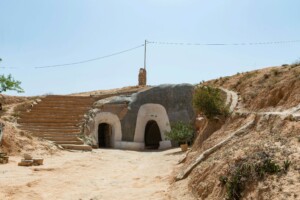
Philosopher Plato is credited with the saying: “Necessity is the mother of invention.” And this can apply to the historical practice of living in caves. In a way, it is an almost instant dwelling and over time, the space carved out of the earth (or naturally occurring) can be insulated. The cave house I reviewed added flooring in the cave rooms as well as paint and electricity. One can review the pros and cons of living in a cave, which is still in practice today in certain countries.
I had the opportunity to review a cave home in Gran Canaria, where most of the bedrooms and current bathrooms were caves on a cliff side, when in generations past the occupants lived as farmers, sharing their living space with domesticated animals.
You can imagine my surprise when the client sent me a floor plan, identifying many rooms on one side of the house as “cuevas.” This was before a video was sent, so I had to use my imagination for a few days. Since their original use in the 1950’s, succeeding occupants added other rooms, including a living room and kitchen, built in the more conventional way with flooring, ceiling and roof.
This job proved to be a challenge when considering how a literal cave does not have the same energy blueprint as a house. In the flying star school, energy from the earth below and the Sun above co-mingle in the house as it’s being built, then sealed in the house when the roof goes on.
With this particular project, I needed to abandon some flying star school principles, and also consider how the qi would move and seep into older spaces, once the conventional part of the house was built and attached to the older part decades later. The house has had several additions and a compass reading that has changed from what it is now, compared to when the land and structures were first used as living spaces.
Over the decades, I have reviewed some highly unusual spaces, including more than one home in New Mexico that looked like a spaceship as well as a caboose (train cabin) turned into a tiny house. I’ve also reviewed homes that started out as barns or non-residential structures from the 1700’s or 1800’s. In some respects, those homes were easier to evaluate than a home where about 50% of the floor plan was cave rooms.
One can also ponder the feng shui implications of bedrooms with no windows, rounded ceilings, and air holes in the ceiling. One can ponder the influence of a house that has had numerous additions and track the logical way in which the qi might migrate. Does qi follow a logical route or can it do something entirely unexpected?
The truth is that some living spaces do not qualify for having a flying star chart, including a boat that one lives in or a mobile home that is also used for transportation, moving around on a regular basis. Certainly, one of the more positive aspects to living in a mountainside is the great views.
I often drift off into my own inter-dimensional musings, noting that the very circumstances which make life as we know it possible on planet Earth may also be the same unique circumstances which create the flying stars. In other words: is there any version of “feng shui” on other planets? Earth + Sun=XXX whereas Venus + Sun= XX, Mercury + Sun= X. The immense differences in gravitational pull from one planet to the next can explain why life as we know it does not exist on other planets in our solar system, at least not on the surface. Living underground and/or in caves has been our past, continues in our present and may be in our future.
Author: Kartar Diamond
Company: Feng Shui Solutions ®
From the Architecture and Design Blog Series
